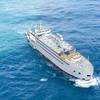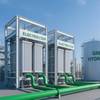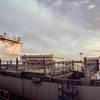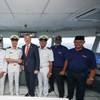Conrad Industries Reports 3Q Results
The Company recorded a gross profit loss of $771,000 (-9.5% of revenue) for the three months ended September 30, 2004 as compared to a gross profit loss of $7,000 (-0.1% of revenue) for the third quarter of 2003. Gross profit was $594,000 (2.1% of revenue) for the nine months ended September 30, 2004, as compared to gross profit of $741,000 (2.8% of revenue) for the first nine months of 2003.
Vessel construction segment revenue increased 23.0% and 5.7%, respectively for the quarter and the first nine months of 2004 compared to the same periods in 2003. Vessel construction hours for the third quarter and the first nine months of 2004 increased 68.2% and 17.2%, respectively compared to the same periods in 2003. The increase in revenue in the current quarter is primarily a result of the overall increase in production hours associated with the entry into the aluminum business and the execution of our backlog.
Vessel construction gross profit was depressed primarily as a result of (1) continuing delays in transitioning from design to production on a major project for four vessels in our backlog and the corresponding lack of overhead absorption, (2) an additional charge recorded in the third quarter of 2004 related to anticipated losses on a commercial contract for the first aluminum vessel at the new aluminum facility which is expected to deliver in the fourth quarter of 2004, and (3) the continued upward pressures on the price of steel. During the third quarter of 2004, we recorded charges on the first two of the four vessel construction project totaling approximately $544,000. The delay in design approval on the four vessel project, which we believe was caused primarily by the customer, caused our overhead rates to rise because we did not take on additional work while we waited for the notice to proceed from the customer. In addition, these delays caused us to incur additional costs to purchase steel and other material for this project as a result of the surging prices of steel and other price increases. In addition we only had one new construction project at our aluminum facility in production during the third quarter and the first nine months of 2004, which is absorbing all of the construction overhead at that facility. That along with increases in the estimated costs of completion caused us to realize an additional charge in the third quarter of 2004 of approximately $468,000 related to anticipated losses on that commercial contract. We previously disclosed recorded charges of $163,000 during the second quarter. The vessel is scheduled for delivery in the fourth quarter.
We added a new aluminum project to our backlog during the third quarter but actual construction did not commence until the fourth quarter. Johnny Conrad, Conrad’s President and CEO commented “During the third quarter, we added $17.3 million to our backlog with the contract awards that we previously announced which include an $8.9 million contract for the design and construction of a 144-foot steel towboat for the US Army Corps of Engineers, a $2.8 million contract to build a 90’ Multi-Purpose High Speed Patrol and Firefighting vessel for the Plaquemines Port, Harbor & Terminal District and a $5.6 million contract to build a 95’ Fish Stocking and Assessment Vessel for the U.S. Fish and Wildlife Service of the Department of the Interior.
We will begin production of the Patrol and Firefighting vessel and the Fish Stock vessel during the fourth quarter of 2004 and during the first half of 2005 for the towboat. We continue to actively pursue all types of vessel construction projects to add to our backlog in order to alleviate some of the upward pressure on our overhead rates and are optimistic that we will add additional contracts during the fourth quarter that are currently under negotiations. We expect the fourth quarter operating results to be improved over the third quarter, although we do not anticipate the full positive effect of our new backlog until the first half of 2005.”
Repair segment revenue for the current quarter increased 17.3% as compared to repair segment revenue for third quarter of 2003 while repair segment gross profit increased 79.4% compared to the same quarter of the prior year. Repair segment revenue increased 15.0% while repair segment gross profit increased 97.2% for the first nine months of 2004 when compared to the same period of last year. Repair hours for the third quarter and the first nine months of 2004 increased 25.7% and 11.9%, respectively, as compared to the same periods in 2003. Repair and conversion gross profit for the current year periods improved primarily as a result of the overhead absorption benefits associated with a single, large, low margin fixed price repair job, as well as the disruptive impact in early 2003 associated with the transition and relocation of our core repair and conversion operations to Conrad Deepwater.
Mr. Conrad added, “The repair segment continues to be difficult due to the low level of activity in the offshore oil and gas markets but we have been able to pursue non-energy related projects to complement our energy related projects to help us maintain the volume of work necessary to be profitable in our repair segment. We are currently negotiating and pursuing both energy and non-energy related projects. The repair segment continues to be very competitive due to the excess capacity of our competitors and low demand for repair and conversion of energy related projects.”













